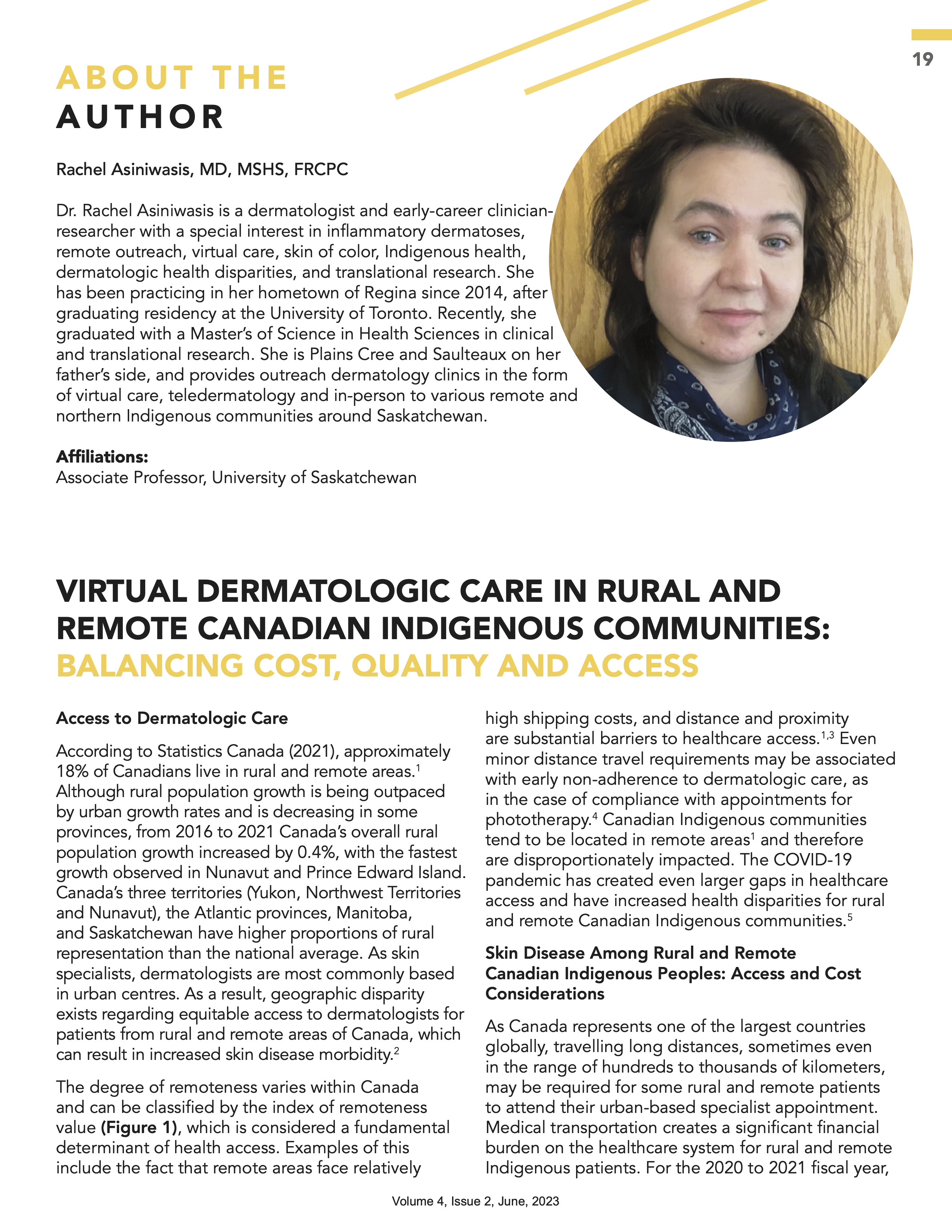Virtual Dermatologic Care in Rural and Remote Canadian Indigenous Communities
Balancing Cost, Quality and Access
Abstract
According to Statistics Canada (2021), approximately 18% of Canadians live in rural and remote areas. Although rural population growth is being outpaced by urban growth rates and is decreasing in some provinces, from 2016 to 2021 Canada’s overall rural population growth increased by 0.4%, with the fastest growth observed in Nunavut and Prince Edward Island. Canada’s three territories (Yukon, Northwest Territories and Nunavut), the Atlantic provinces, Manitoba, and Saskatchewan have higher proportions of rural representation than the national average. As skin specialists, dermatologists are most commonly based in urban centres. As a result, geographic disparity exists regarding equitable access to dermatologists for patients from rural and remote areas of Canada, which can result in increased skin disease morbidity.
The degree of remoteness varies within Canada and can be classified by the index of remoteness value, which is considered a fundamental determinant of health access. Examples of this include the fact that remote areas face relatively high shipping costs, and distance and proximity are substantial barriers to healthcare access. Even minor distance travel requirements may be associated with early non-adherence to dermatologic care, as in the case of compliance with appointments for phototherapy. Canadian Indigenous communities tend to be located in remote areas and therefore are disproportionately impacted. The COVID-19 pandemic has created even larger gaps in healthcare access and have increased health disparities for rural and remote Canadian Indigenous communities.
References
Statistics Canada. Population Growth in Canada’s Rural Areas, 2016 to 2021. Available from: https://www12.statcan.gc.ca/census-recensement/2021/as-sa/98-200-x/2021002/98-200-x2021002-eng.cfm
Li A, Toy J, Purdy K, Kirshen C, Liu C. Rural Educational Opportunities in Dermatology Residency Programs: The Solution to Geographic Maldistribution and Shortage of Dermatologists in Canada? Journal of Cutaneous Medicine and Surgery. 2023 Jan 18:12034754221149653.
Goins RT, Williams KA, Carter MW, Spencer SM, Solovieva T. Perceived barriers to health care access among rural older adults: a qualitative study. The Journal of Rural Health. 2005 Jun;21(3):206-13.
Weng QY, Buzney E, Joyce C, Mostaghimi A. Distance of travel to phototherapy is associated with early nonadherence: a retrospective cohort study. Journal of the American Academy of Dermatology. 2016 Jun 1;74(6):1256-9.
Heck C, Eaker M, Cobos S, Campbell S, Carnevale FA. Pandemic impacts for indigenous children and youth within Canada: an ethical analysis. Young. 2021 Sep;29(4):381-98.
Indigenous Services Canada. Non-Insured Health Benefits Program: First Nations and Inuit Health Branch: Annual Report 2020 to 2021. Ottawa: Government of Canada; 2022 May 19. Available from: https://www.sac-isc.gc.ca/eng/1645718409378/1645718500555.
Indigenous Services Canada. Non-Insured Health Benefits Program: First Nations and Inuit Health Branch: Annual Report 2016-2017. Ottawa: Government of Canada; 2021 Nov 1. Available from: https://www.sac-isc.gc.ca/eng/1580856446382/1580857815920.
Organisation for Economic Cooperation and Development (OECD). Profile of Indigenous Canada: Trends and Data Needs. Linking Indigenous Communities with Regional Development in Canada. 2020 Jan 21;1:67-133. DOI: https://doi.org/10.1787/e6cc8722-en.
Asiniwasis RN, Eglington T, Odeshi O, Richels L, Hinther K, Phillips Z, Pandey M. Saskatchewan Rural Communities and Skin Diseases: A Health Practitioner Survey on Dermatologic Conditions seen in Saskatchewan’s Remote Indigenous Communities. Presented at: 14th Saskatchewan Health Research Showcase; 2020 Nov 16–18; [virtual] Saskatchewan Health Authority, SK.
Asiniwasis R, Odeshi O, Richels L, Eglington T, Phillips Z, Hinther K, Merati N, Campbell T, Pandey M. Virtual Dermatology Clinics in Remote and Northern Saskatchewan Indigenous Communities: Addressing Challenges and Exploring Opportunities. Poster presented at: 15th Saskatchewan Health Research Showcase; 2021 Nov 16–18; Saskatchewan Health Authority, SK.
First Nations Information Governance Centre (FNIGC). First Nations Regional Health Survey (RHS) 2008/10: National report on adults, youth and children living in First Nations communities. Ottawa: FNIGC; 2012.
First Nations Information Governance Centre (FNIGC). National Report of the First Nations Regional Health Survey: Phase 3: Volume One. Ottawa: FNIGC; 2018.
Morenz AM, Wescott S, Mostaghimi A, Sequist TD, Tobey M. Evaluation of barriers to telehealth programs and dermatological care for American Indian individuals in rural communities. JAMA Dermatology. 2019 Aug 1;155(8):899-905.
Government of Canada. High-Speed Access for All: Canadian’s Connectivity Strategy. Ottawa: Government of Canada; 2019 Jul 16. Available from: https://www.ic.gc.ca/eic/site/139.nsf/eng/h_00002.html.
American Academy of Dermatology: Native American Health Service Resident Rotation Program.
[Internet]. 2017 Apr. Available from: https://research.weill.cornell.edu/funding/open-submission-grants/american-academy-dermatology-native-american-health-service-resident.
Kozera EK, Yang A, Murrell DF. Patient and practitioner satisfaction with tele-dermatology including Australia’s indigenous population: A systematic review of the literature. International Journal of Women’s Dermatology. 2016 Sep 1;2(3):70-3.
First Nations Information Governance Centre (FNIGC). First Nations Principles of OCAP. [Internet]. Ottawa: FNIGC; 2022. Available from: https://fnigc.ca/ocap-training/.
Statistics Canada. Remoteness Zones of Canada, 2021. In: Population growth in Canada’s rural areas, 2016 to 2021. Ottawa: Statistics Canada; 2022 Dec 15. Available from: https://www12.statcan.gc.ca/census-recensement/2021/as-sa/98-200-x/2021002/98-200-x2021002-eng.cfm.
Indigenous Services Canada. Non-Insured Health Benefits Program: First Nations and Inuit Health Branch: Annual Report 2020 to 2021. Government of Canada; 2022. Available from: https://www.sac-isc.gc.ca/eng/1645718409378/1645718500555
Nash P, Kerschbaumer A, Dörner T, et al. Points to consider for the treatment of immune-mediated inflammatory diseases with Janus kinase inhibitors: a consensus statement. Ann Rheum Dis. 2021;80(1):71-87.


